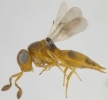 |
Scientific nameCeratobaeus sp.
Taxonomic positionHymenoptera: Platygastroidea: Platygastridae: Scelioninae
DiagnosisFemale: Length 1.2-1.5mm. Head and body black to brownish yellow; frons without a median depression; a few carinae radiating from mandibular corners towards orbital margin; antenna 7-segmented in females, clava large without a distinct segmentation; in males 12- segmented, 11th and 12th separated by only a suture; T1 in females produced into a horn or a hump fitting into a concavity on median mesosoma; fore wings with well developed marginal and stigmal veins; hind wing with submarginal vein complete (Masner, 1976; Mani & Sharma, 1982; Austin & Field, 1997; Iqbal & Austin, 2000).
ImageDistributionIndia: Kerala, Karnataka, Tamil Nadu, Uttarakhand, Maharashtra and Uttar Pradesh.
Biology / HostsEggs of spiders belonging to Clubionidae, Salticidae, Gnaphocidae, Lamponidae, Stiphididae (Iqbal & Autsin, 2000).
References
CreditsFactsheet prepared by Dr. A. Rameshkumar, Research associate, NPIB, NBAII.
|

